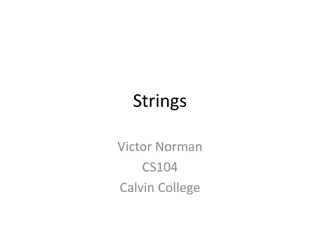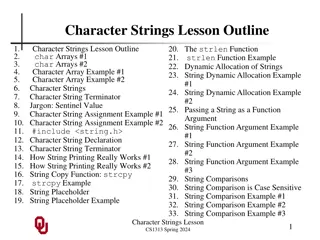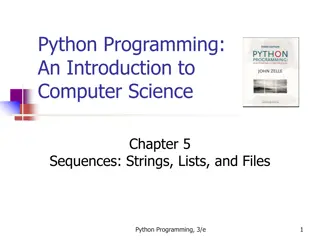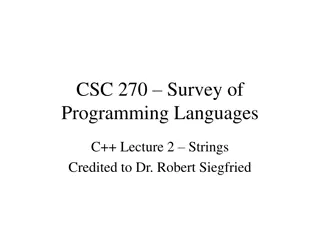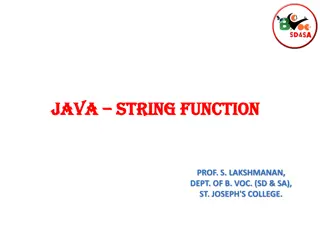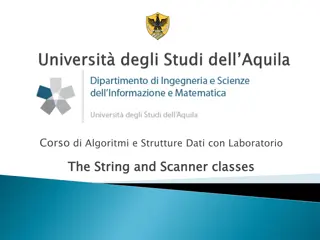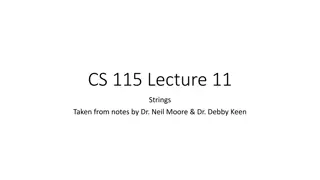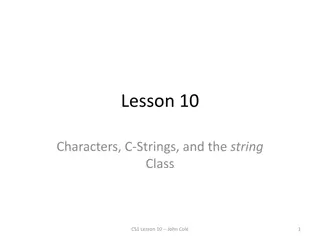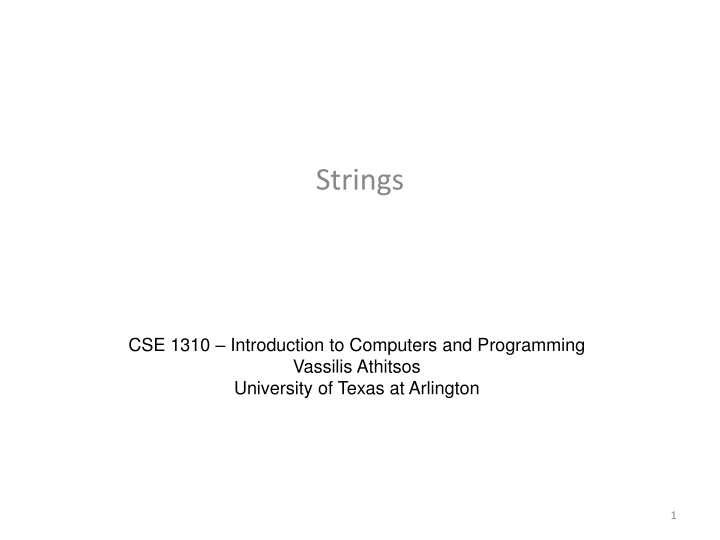
Introduction to Strings in Python Programming
Learn about strings in Python programming, including storing text, accessing elements, and string concatenation. Understand how to work with strings in a simple program and explore examples of string manipulation. Improve your coding skills with this essential guide to understanding and utilizing strings effectively.
Download Presentation

Please find below an Image/Link to download the presentation.
The content on the website is provided AS IS for your information and personal use only. It may not be sold, licensed, or shared on other websites without obtaining consent from the author. If you encounter any issues during the download, it is possible that the publisher has removed the file from their server.
You are allowed to download the files provided on this website for personal or commercial use, subject to the condition that they are used lawfully. All files are the property of their respective owners.
The content on the website is provided AS IS for your information and personal use only. It may not be sold, licensed, or shared on other websites without obtaining consent from the author.
E N D
Presentation Transcript
Strings CSE 1310 Introduction to Computers and Programming Vassilis Athitsos University of Texas at Arlington 1
Strings Store Text In the same way that int and float are designed to store numerical values, the string type is designed to store text. Strings can be enclosed in: single quotes, double quotes, or triple double quotes. Examples: name = 'George' phone_number = "310-123-987" message = """Please go shopping. We need milk, cereal, bread, cheese, and apples. Also, put gas in the car.""" 2
A Simple Program Using Strings text = input("please enter a day: ") weekdays = ['Monday', 'Tuesday', 'Wednesday', 'Thursday', 'Friday'] weekend = ['Saturday', 'Sunday'] if (text in weekdays): print('This is a weekday') elif (text in weekend): print('This is a weekend day') else: print('This is not a valid day') 3
Accessing the Elements of a String Accessing elements of a string is done as in lists, using the [] operator. >>> a = 'hello' >>> a[0] 'h' >>> a[2] 'l' >>> a[1:3] 'el' >>> a[-1] 'o' >>> a[-2] 'l' 4
Accessing the Elements of a String Accessing elements of a string is done as in lists, using the [] operator. >>> 'goodbye'[3] 'd' >>> 'goodbye'[4:1:-1] 'bdo' >>> 'goodbye'[::2] 'gobe' >>> 'goodbye'[:4] 'good' >>> 'goodbye'[4:] 'bye' 5
Concatenation Using The + Operator The string1+string2 expression produces the concatenation of string1 and string2. >>> a = "hello" >>> b = a + " " + "world" >>> print(b) hello world 6
Concatenation Using The += Operator The string1 += string2 statement assigns to string1 the concatenation of string1 and string2. >>> c = "Arlington" >>> c += ", TX" >>> print(c) Arlington, TX 7
The * Operator on Strings >>> a = "hello" >>> a*3 'hellohellohello' The string*integer expression repeats a string as many times as the integer specifies. 8
For Loops with Strings Print out all letters in a string. OUTPUT: found letter h found letter e found letter l found letter l found letter o found letter found letter w found letter o found letter r found letter l found letter d text = "hello world" for letter in text: print('found letter', letter) 9
String Comparisons >>> my_strings = ["Welcome", "to", "the", "city", "of", "New", "York"] >>> my_strings ['Welcome', 'to', 'the', 'city', 'of', 'New', 'York'] >>> my_strings.sort() >>> my_strings ['New', 'Welcome', 'York', 'city', 'of', 'the', 'to'] Python uses a string order of its own. Follows alphabetical order, with the exception that capital letters are always before lower case letters. 10
String Comparisons It is easy to verify the order that Python uses, by trying out different pairs of strings. >>> "hello" < "goodbye" False >>> "Hello" < "goodbye" True >>> "ab" > "abc" False 11
String Comparisons >>> "123" < "abc" True >>> "123" < "ABC" True Numbers come before letters. Guideline: do not memorize these rules, just remember that Python does NOT use exact alphabetical order. 12
String Comparisons >>> "123" == 123 What will this line produce? 13
String Comparisons >>> "123" == 123 False What will this line produce? False, because a string cannot be equal to a number. 14
String Comparisons >>> "123" < 150 What will this line produce? 15
String Comparisons >>> "123" < 150 Traceback (most recent call last): File "<pyshell#195>", line 1, in <module> "123" < 123 TypeError: unorderable types: str() < int() What will this line produce? An error message, because comparisons between strings and numbers are illegal in Python. 16
Strings Cannot Change >>> a = "Munday" >>> a[1] = 'o' Traceback (most recent call last): File "<pyshell#297>", line 1, in <module> a[1] = 'o' TypeError: 'str' object does not support item assignment 17
If You Must Change a String You cannot, but you can make your variable equal to another string that is what you want. Example: >>> my_string = "Munday" my_string contains a value that we want to correct. >>> my_string = "Monday" We just assign to variable my_string a new string value, that is what we want. 18
For More Subtle String Changes Suppose that we want a program that: Gets a string from the user. Replaces the third letter of that string with the letter A. Prints out the modified string. We just assign to variable my_string a new string value, that is what we want. 19
For More Subtle String Changes Strategy: convert string to list of characters do any manipulations we want to the list (since lists can change) convert list of characters back to a string 20
An Example Write a program that: Gets a string from the user. Modifies that string so that position 3 is an A. Prints the modified string. 21
An Example my_string = input("please enter a string: ") if (len(my_string) >= 3): # convert string to list, make the desired change (change third letter to "A") my_list = list(my_string) my_list[2] = "A"; # create a string out of the characters in the list new_string = "" for character in my_list: new_string = new_string + character my_string = new_string print("the modified string is", my_string) 22
A Variation my_string = input("please enter a string: ") my_string = my_string[0:2] + "A" + my_string[3:] print("the modified string is", my_string) 23
The in Operator The in operator works for lists and strings. Syntax: element in container Returns true if the element appears in the container, false otherwise. >>> a = [1, 2, 3] >>> 2 in a True >>> 5 in a False >>> vowels = 'aeiou' >>> "a" in vowels True >>> "k" in vowels False 24
upper and lower The string.upper() method returns a new string where all letters are upper case. The string.lower() method returns a new string where all letters are lower case. Note: upper() and lower() do not modify the original string, they just create a new string. Should be obvious, because strings cannot be modified. >>> vowels = 'aeiou' >>> b = vowels.upper() >>> vowels 'aeiou' >>> b 'AEIOU' >>> a = 'New York City' >>> b = a.lower() >>> b 'new york city' 25
The len Function Similar as in lists, len returns the number of letters in a string. >>> len('hello') 5 26
Reversing a String >>> a = "hello" >>> b = a[::-1] >>> b 'olleh' >>> a[3:0:-1] 'lle' Slicing with step -1 can be used to reverse parts, or all of the string. 27
The index method >>> a = [10, 11, 12, 10, 11] >>> a.index(10) 0 >>> a.index(11) 1 The my_list.index(X) method returns the first position where X occurs. Gives an error if X is not in my_list. >>> b = "this is crazy" >>> b.index('i') 2 >>> b.index('cr') 8 The my_string.index(X) behaves the same way, but: X can be a single letter or more letters. 28
The find method The my_string.find(X) method, like index, returns the first position where X occurs. X can be a single letter or more letters. Difference from index: my_string.find(X) returns -1 if X is not found. >>> b = "this is crazy" >>> b.find('is') 2 >>> b.find('q') -1 29
The isspace method The my_string.isspace() method, returns True if the string only contains white space (space, tab, newline). X can be a single letter or more letters. " " is the space character. "\t" is the tab character. "\n" is the newline character. >>> b = "\t\n \t" >>> b.isspace() True >>> "hello".isspace() False 30
The strip method The my_string.strip() method, returns a string that is equal to my_string, except that white space (space, tab, newline) has been removed from the beginning and the end of my_string. White space in the middle of the string (between non- white-space characters) is not removed. >>> a = " hello world " >>> b = a.strip() >>> b 'hello world' 31
Converting Other Types to Strings The str function converts objects of other types into strings. >>> a = 2012 >>> b = str(a) >>> b '2012' Note: str does NOT concatenate a list of characters (or strings). See example on left. >>> a = ['h', 'e', 'l', 'l', 'o'] >>> b = str(a) >>> b "['h', 'e', 'l', 'l', 'o']" 32
Converting Strings Into Ints/Floats The int, float functions convert strings to integers and floats. Will give error message if the string does not represent an integer or float. >>> a = '2012' >>> b = int(a) >>> b 2012 >>> float(a) 2012.0 >>> a = "57 bus" >>> int(a) <error message> 33
ASCII Codes Each letter corresponds to an integer, that is called the ASCII code for that letter. The ord function can be used to get the ASCII code of a letter. 34
ASCII Codes Each letter corresponds to an integer, that is called the ASCII code for that letter. The ord function can be used to get the ASCII code of a letter. OUTPUT: h 104 e 101 l 108 l 108 o 111 32 w 119 o 111 r 114 l 108 d 100 for i in 'hello world': print(i, ord(i)) 35
From ASCII Code to Character The chr function can be used to get the letter corresponding to an ASCII code. 36
From ASCII Code to Character The chr function can be used to get the letter corresponding to an ASCII code. list1 = [104, 101, 108, 108, 111] text = "" OUTPUT: for item in list1: text = text + chr(item) text = hello print("text =", text) 37
Converting Strings Into Lists The list function can convert a string to a list. Always works. Very handy if we want to manipulate a string's contents and create new strings based on them. >>> a = "hello" >>> list(a) ['h', 'e', 'l', 'l', 'o'] 38
Converting a List to a String To convert a list to a string, do not use the str function. >>> a = list('hello') >>> a ['h', 'e', 'l', 'l', 'o'] >>> b = str(a) >>> b "['h', 'e', 'l', 'l', 'o']" 39
Converting a List to a String To convert a list to a string, use a for loop. a = ['h', 'e', 'l', 'l', 'o'] b = "" for letter in a: b = b+letter >>> b 'hello' 40
Example: Strings to Lists and Back # sort all the letters in a string. OUTPUT: text = input('Enter some text: ') text_list = list(text) text_list.sort() Enter some text: hello world The sorted text is: dehllloorw new_text = "" for letter in text_list: new_text = new_text + letter print("The sorted text is:", new_text) 41




